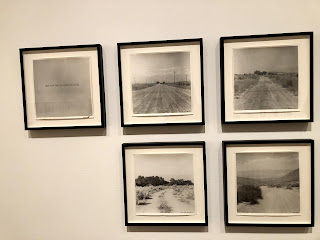For my second event I attended the Getty Museum not far from here at UCLA. It was my first time ever going to the Getty and I was surprised by how beautiful it was. Not only was the art inside of it amazing but also the building architecture itself. It has views of LA where you can see for miles and beautiful geometric patterns in the garden. Although I walked through almost all the exhibits i'm going to focus on one in this blog post.
Above is Robert Kinmont's "My Favorite Dirt Roads" which depicts unpaved roads leading to Bishop, California. These photos capture the mostly empty landscape with the few occasional power lines suggesting some civilization. Robert Kinmont uses the idea of perspective in these images as he decided to stand in the middle of the road and have the road meet at the horizon.
Pictured above is Uta Barth's work. The artist had interest in the use of photography to understand the environment. After photographing her surroundings Barth marks the surface of these photos with grease pencils. The numbers, brackets, and lines as part to draw attention to certain points of the images. She shows an intention to create a rational design along with incorporate geometric patterns and golden ration. She also uses the idea of how patterns and lines can change the viewers perspective and draw attention to different areas of the photographs.



Comments
Post a Comment